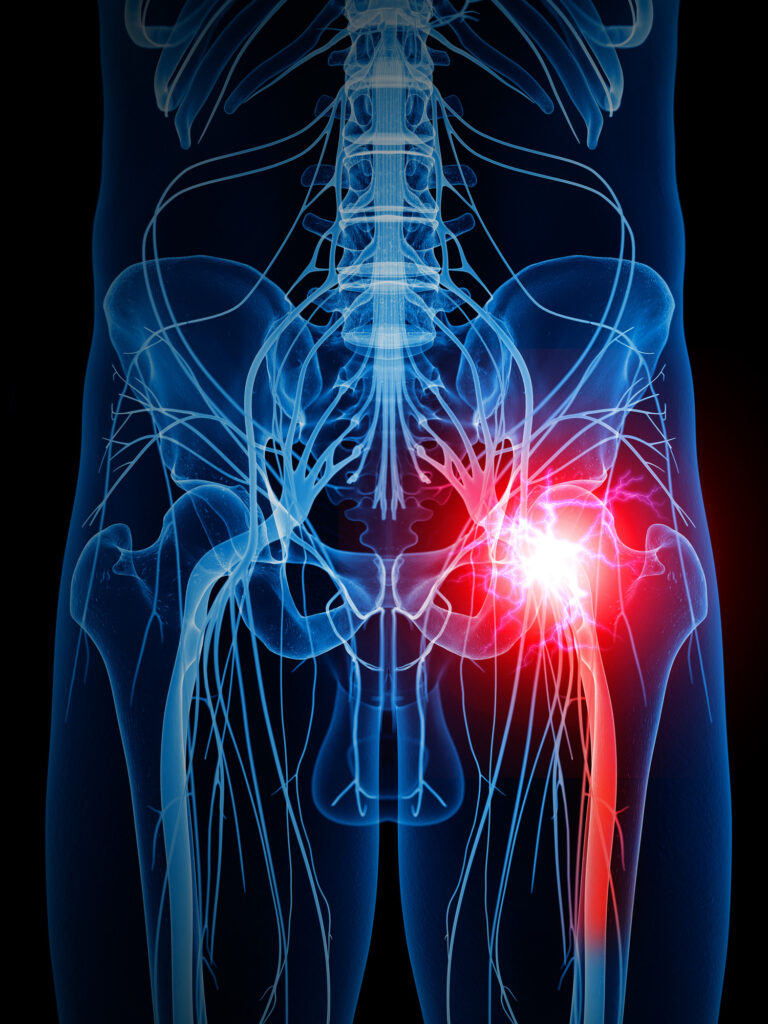Sciatic Nerve Pain – What is it?
A short synopsis of sciatic nerve pain is presented below form the Harvard School of Health. Remember to please only treat this as guidance. You can always give us a call or book an appointment and we would be glad to advise professionally.

What is sciatica?
Sciatica refers to pain caused by the sciatic nerve that carries messages from the brain down the spinal cord to the legs. The pain of sciatica typically radiates down one side from the lower back into the leg, often below the knee. The most common cause is a bulging (“herniated”) disc in the lower back. Discs are tire-like structures that sit between the bones of the spine. If the outer rim of the disc tears, usually due to routine pressure on the lower back, the jelly-like inner material can come out and pinch or inflame the nearby nerve. Sciatica is most common in people 30 to 50.
How do you know if it is sciatica?
The key to diagnosing sciatica is a thorough history and a focused exam. Unfortunately, many patients expect an x-ray or MRI, and doctors, often facing time constraints, order one even though we know imaging tests don’t really help us treat early sciatica any better. The Sciatica symptoms are often worse with sitting or coughing and may be accompanied by numbness or tingling in the leg. A physical exam can confirm that the sciatic nerve is involved, and I look for weakness or diminished reflexes in the legs that suggest that someone needs early referral to a specialist. (This doesn’t happen often.) With this information, I can make an initial diagnosis and start treatment.
Treating sciatica pain… and managing expectations
Many people think (understandably) that the worse the pain, the more likely something bad is going on. However, this isn’t true for sciatica. The body can reabsorb the disc material that is causing symptoms, even for those with severe pain. So, treatment focuses on controlling pain and keeping people as active as possible. If the pain is excruciating, lying down for short periods can help, but prolonged bed rest does not. So, once the pain diminishes, I tell patients to get up and start walking short distances. Since sitting increases pressure on the discs in the lower back, I recommend avoiding prolonged sitting or driving. Many people try treatments like physical therapy, massage, acupuncture, and chiropractic manipulation, but evidence suggests that while these approaches may help typical low back pain, they are less helpful for sciatica. Over-the-counter pain medicines like ibuprofen and naproxen can help. When they don’t, I may recommend short-term use of stronger, prescription pain medicines.
The good news is that for most (roughly three out of four) people, symptoms improve over a few weeks. Rarely, I’ll find weakness on exam, such as a foot drop, and refer for immediate surgical evaluation. For those not improving after six weeks, surgery is an option. We know surgery can speed up recovery, but by six to 12 months people who have surgery are usually doing about as well as those who decide to just give the body more time to heal on its own. Surgery involves removing the disc material that is affecting the nerve. It is generally a very safe procedure, and while complications are rare, they can happen. What’s more, 5% to 10% of people who have surgery will not be helped by it or may have worse pain afterwards.
Patients often ask about spinal injections — where steroid medicine is injected into the affected area. It is worth considering for those with uncontrolled pain or for those with persistent, bothersome symptoms who want to avoid surgery. Injections can provide short-term relief. Like any procedure, it has uncommon risks including more pain, and it doesn’t seem to decrease the need for future surgery.
Staying patient-focused… and “hurt” doesn’t always mean “harm”
For most patients with sciatica, it’s worth seeing your primary care doctor. Patients who come in are often scared. Typically, it is pain the likes of which they may have never had. They want relief and, rightly, they want it now. That is the appeal of surgery and injections, but I also know that most will get better with time and can avoid even the uncommon risks of these procedures. When I see a patient in my office I can assess and identify the few who need immediate referral to a specialist. But for most, I try to reassure that hurt doesn’t mean harm, and that my treatments are geared to managing pain and keeping them active while the body fixes itself. For those not improving, I will get an MRI prior to referring for surgery or an injection, if the patient decides that speeding up recovery is right for them. For those who feel that they can manage the pain, I can reassure them that they can delay surgery for up to six months without risking long-term problems down the road.
Please come and visit us by clicking here, we would be glad to help.
Sources
- Herniated lumbar intervertebral disk. New England Journal of Medicine, May 2016.
- Evaluating and managing acute low back pain in the primary care setting. Journal of General Internal Medicine, February 2001.
- Epidural corticosteroid injections for radiculopathy and spinal stenosis. Annals of Internal Medicine, September 2015.
Article Written By
- Steven J. Atlas, MD, MPH, Contributor Harvard Health
